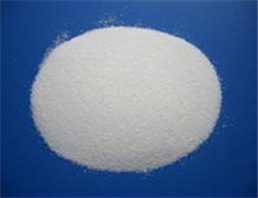
Docetaxel
| Price | $35 |
| Package | 1KG |
| Min. Order: | 1KG |
| Supply Ability: | 100 KG |
| Update Time: | 2020-11-16 |
Product Details
| Product Name: Docetaxel | CAS No.: 114977-28-5 |
| Min. Order: 1KG | Purity: 99% |
| Supply Ability: 100 KG | Release date: 2020/11/16 |
| Product Name: | Docetaxel |
| Synonyms: | Benzenepropanoic acid, β-[[(1,1-dimethylethoxy)carbonyl]amino]-α-hydroxy-, (2aR,4S,4aS,6R,9S,11S,12S,12aR,12bS)-12b-(acetyloxy)-12-(benzoyloxy)-2a,3,4,4a,5,6,9,10,11,12,12a,12b-dodecahydro-4,6,11-trihydroxy-4a,8,13,13-tetramethyl-5-oxo-7,11-methano-1H-cyclodeca[3,4]benz[1,2-b]oxet-9-yl ester, (αR,βS)-;Docetaxel N-debenzoyl-N-tert-butoxycarbonyl-10-deacetyl taxol;Taxotere anhydrous;Decetaxel;TAXOTERE;n-debenzoyl-n-tert-butoxycarbonyl-10-deacetyl taxol;)benz(1,2-b)oxet-9-ylester,(2ar-(2a-alpha,4-beta,4a-beta,6-beta,9-alpha(alph;-,12b-(acetyloxy)-12-(benzoyloxy)-2a,3,4,4a,5,6,9,10,11,12,12a,12b-dodecahydr |
| CAS: | 114977-28-5 |
| MF: | C43H53NO14 |
| MW: | 807.87922 |
| EINECS: | 1806241-263-5 |
| Product Categories: | Inhibitors;Pharmaceutical material and intermeidates;Taxotere;Active Pharmaceutical Ingredients;Antineoplastics;Antineoplastic;Plant extracts;Herb extract;API;chemical reagent;pharmaceutical intermediate;phytochemical;reference standards from Chinese medicinal herbs (TCM).;standardized herbal extract;inhibitor;Anti-cancer&immunity |
| Mol File: | 114977-28-5.mol |
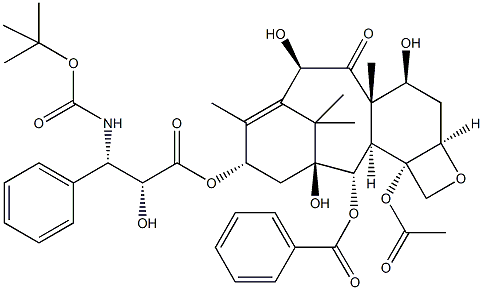 |
|
| Docetaxel Chemical Properties |
| Melting point | 186-192 °C (dec.) |
| alpha | -36 º (c=0.74,EtOH) |
| density | 1.38 |
| storage temp. | Store at +4°C |
| Water Solubility | Soluble in dimethyl sulfoxide and ethanol. Insoluble in water. |
| Merck | 14,3397 |
| InChIKey | BEDLLNJKXXVTSX-LWWLJZAUSA-N |
| CAS DataBase Reference | 114977-28-5(CAS DataBase Reference) |
| Safety Information |
| Hazard Codes | Xi |
| Risk Statements | 36/37/38-61 |
| Safety Statements | 26-36/37-53-45 |
| RIDADR | 1544 |
| RTECS | DA4172750 |
| HazardClass | 6.1(b) |
| PackingGroup | III |
| HS Code | 29322090 |
| Hazardous Substances Data | 114977-28-5(Hazardous Substances Data) |
| Docetaxel Usage And Synthesis |
| Indications and Usage | Docetaxel is a taxane, antineoplastic, and anticancer drug used to treat locally advanced or metastatic breast cancer, even after the failure of cisplatin therapy. Its anti-tumor efficacy has been proven in in vitro tests to be 1.3-12 times that of paclitaxel. Clinical studies have shown that it is more effective than paclitaxel against anthracycline resistant breast cancer. Docetaxel is currently the most effective for the second-line treatment of anthracycline resistant breast cancer. In single cell therapy and combined chemotherapy for non-small cell lung cancer, it is one of the most effective drugs. It can be used for cancer of the uterus, and to study antibiotics, cell biology, cell signaling, neuroscience, apoptosis, and cell cycles. It is also used to study hair loss caused by docetaxel chemotherapy, and to prevent and treat small-cell lung cancer in patients contraindicated for chemotherapy. It is also used to investigate the roles of hypoxia-inducible factors-1α and 2α in androgen-insensitive prostate cancer cells. |
| Mechanisms of Action | Docetaxel promotes microtubule stabilization by promoting the assembly of microtubule dimers into microtubules, and preventing depolymerization, thus blocking cells in the G2 and M stages, and inhibiting the mitosis and proliferation of cancer cells. Its pharmacological effects are stronger than those of paclitaxel, with 3 times the intracellular concentration and long retention time within the cell, and twice the microtubule affinity; As a microtubule stabilizer and assembly promoter, its activity is twice that of paclitaxel; as a microtubule depolymerization inhibitor, its activity is also twice that of paclitaxel. |
| Pharmacokinetics | In a pharmacokinetic study in which cancer patients took 20-115 mg/m2, when the dose was 75-115 mg/m2 over a 1-2 hour intravenous drip, AUC was correlated with dose. Its pharmacokinetic characteristics conform to a three-compartmental pharmacokinetic model, with α, β, and γ half-lives of 4, 36, and 11.1 hours respectively. The concentration of the initial phase decreased rapidly, indicating that the drug was distributed to the peripheral compartment. The latter phase is partly due to the relatively slow elimination of the drug from the compartment. Within an hour of intravenous infusion of 100 mg/m2 of paclitaxel, the average peak was 3.7 ug/ml, AUC was 4.6 ug/ml•h, and total clearance and steady-state distribution were 21 L/h/m2 and 113 L. In vitro studies have shown that it has a plasma protein binding rate of more than 94-97%, and dexamethasone does not affect its protein binding. Docetaxel and its metabolites are mainly excreted from feces. Fecal and urinary excretion accounted for 75% and 6% of the dose, and only a small part is excreted in original form. In vitro studies have shown that docetaxel is metabolized by CYP3A4 isoenzymes, which can be inhibited by CYP3A4 inhibitors. |
| Clinical Research | Genotoxicity: docetaxel induced fractures in CHO-K1 cellular chromosome aberration tests and mouse bone marrow micronucleus tests, but no mutagenicity was observed in Ames tests and CHO/HGPRT gene mutation tests. Reproductive toxicity: no damage to fertility upon intravenous injection 0.3 mg/kg in mice (calculated by body surface area, about 1/50 of the recommended clinical dosage), but could cause reduction in testicular weight. This result is correlated with the results of repeatedly administering it to rats and dogs for 10 cycles (administered once every 21 days, for 6 months); when the intravenous doses were 5 mg/kg and 0.375 mg/kg respectively (converted by surface area, 1/3 and 1/15 of the recommended clinical dose, respectively), testicular atrophy and degeneration were observed. Similar effects were also observed in rats when given low doses more frequently. When rats and rabbits were given ≥0.3 mg/kg/day and 0.03 mg/kg/day (converted from surface area, respectively equivalent to 1/50 and 1/300 of the clinically recommended dose) during organogenesis), embryonic and fetal toxicity was observed (manifesting as intrauterine death, absorbed fetus, and fetal weight loss and delayed ossification). The above dose may case maternal toxicity. |
| Drug Interactions | In vitro studies have found that CYP3A4 inhibitors may interfere with the metabolism of docetaxel, so it should be used with caution in combination with such drugs (such as ketoconazole, erythromycin, cyclosporine, etc.) |
| Adverse Reactions | 1. Bone marrow suppression: neutropenia is the most common adverse reaction is usually severe (under 500/mm3). Reversible and does not accumulate. Fever and infection associated with neutropenia have been reported in the literature. Anemia can be seen in most cases, with rare severe thrombocytopenia. 2. Allergic reactions: some patients experience severe allergic reactions, characterized by hypotension and bronchospasm, requiring interruption of treatment. The patient can return to normal immediately after discontinuing treatment. Mild allergic reactions, such as blush (with or without itchy erythema), chest tightness, back pain, difficulty breathing, drug fever, or chills, occur in some patients. 3. Skin reactions are usually manifest as erythema, mainly local rashes on hands and feet, sometimes also on arms, face, and chest, sometimes accompanied by itching. Rashes usually occur within a week of infusion, but can return before the next infusion. Severe symptoms, such as peeling after skin rash, occur rarely. Fingernail (or toenail) lesions may occur, characterized by hyperpigmentation or thinning, and sometimes pain and nail loss. 4. Fluid retention: edema, and a few reported cases of pleural effusion, ascites, pericardial effusion, increased capillary permeability, and weight gain. Lower limb fluid retention after four cycles of treatment or cumulative dose of 400mg/m2 may develop into systemic edema, and weight gain of 3kg or more. After discontinuing treatment, fluid retention gradually disappears. Corticosteroids should be given to prophylactically reduce fluid retention. 5. Gastrointestinal reactions such as nausea, vomiting, or diarrhea may occur. 6. There have been reports of neurotoxicity in clinical trials. 7. Cardiovascular adverse reactions such as hypotension, sinus tachycardia, palpitations, pulmonary edema, and hypertension may occur. 8. Other adverse reactions may include: hair loss, weakness, mucositis, joint and muscle pain, hypotension, and reaction at injection site. 9. Patients with normal liver function have also experienced elevated transaminase during treatment. For those with elevated bilirubin, the relationship with docetaxel is still unclear. |
| Contradictions | 1 Patients with a history of severe allergic sensitivity to docetaxel or polysorbate-80. 2 Patients with white blood cell count under 1500/mm3. 3 Patients with severe liver damage. |
| Precautions | At present there is still insufficient strictly controlled clinical data for pregnant women. Patient who are a pregnant woman or become pregnant while using docetaxel should be informed of potential damage to the fetus and risk of miscarriage. Women who may become pregnant during treatment should use birth control. It is not clear whether docetaxel is excreted from human milk. Given that many drugs may be excreted from human milk, and that docetaxel may have serious adverse reactions for breastfeeding infants, mothers should stop breastfeeding before treatment. The efficacy and safety of docetaxel in children has not yet been determined. |
| Chemical Properties | Off-white Cryst |
| Uses | antineoplastic;binds to microtubules |
| Definition | ChEBI: A tetracyclic diterpenoid that is paclitaxel with the N-benzyloxycarbonyl group replaced by N-tert-butoxycarbonyl, and the acetoxy group at position 10 replaced by a hydroxy group. |
| Uses | Docetaxel is a semisynthetic analog of taxol that inhibits microtubule disassembly (IC50 = 0.2 μM) and inhibits cell replication (IC50 = 0.13 μM). It has proven more effective than taxol in preventing the proliferation of cancer cells. Docetaxel has applications in breast cancer and hormone-refractory prostate cancer. This product is intended for research applications. |
Company Profile Introduction
Longyan Tianhua Biological Technology Co., Ltd is located in Longyan city, Fujian Province, China. It is a large-scale high-tech integrated enterprise dedicated to the research, development and sales of fine chemicals, pharmaceutical raw material intermediates, food and feed additives.
The company has its own research and development base, equipped with advanced production equipment and efficient and precise testing instruments, has set up a strict and scientific quality management system, and constantly committed to technological innovation, product innovation and management innovation, so as to ensure that our products have super competitiveness in the same industry.?
Company's main: Phenformin Hydrochloride, Chlorhexidine Acetate, Indomethacin Biphenyl benzyl azole dyclonine hydrochloride clorprenaline hydrochloride griseofulvin chloramphenicol maleic acid to guangxi pp qi, fucus xanthine tert-butyl of hydroxy anisole (BHA), ammonia, benzene pteridine zonisamide moxifloxacin mother nucleus moxifloxacin side chain moxifloxacin hydrochloride clobetasol propionate tranexamic acid raw material, and so on.?
The annual sales volume of the company is around 3 million DOLLARS. Its products have been sold to more than 40 countries and regions all over the world, and have been well received. Moreover, the buyback rate of customers is very high.
Longyan Tianhua Biotechnology Co., LTD. Is looking forward to long-term cooperation with you.
You may like
Recommended supplier
| Product name | Price | Suppliers | Update time | |
|---|---|---|---|---|
| $30.00/25mg |
VIP5Y
|
TargetMol Chemicals Inc.
|
2024-11-19 | |
| $30.00/25mg |
VIP1Y
|
TargetMol Chemicals Inc.
|
2024-11-19 | |
| $0.00/1g |
VIP1Y
|
BEIJING SJAR TECHNOLOGY DEVELOPMENT CO., LTD.
|
2024-10-11 | |
| $10.00/1KG |
VIP4Y
|
Hebei Chuanghai Biotechnology Co,.LTD
|
2024-08-14 | |
| $130.00/100mg |
VIP2Y
|
Zibo Hangyu Biotechnology Development Co., Ltd
|
2024-07-10 | |
| $0.00/1KG |
VIP2Y
|
Hangzhou Hyper Chemicals Limited
|
2024-06-28 | |
| $0.00/1kg |
VIP1Y
|
Shaanxi TNJONE Pharmaceutical Co., Ltd
|
2024-04-15 | |
| $0.00/25kg |
Shaanxi Haibo Biotechnology Co., Ltd
|
2023-09-07 | ||
| $10.00/1kg |
Henan Bao Enluo International TradeCo.,LTD
|
2023-07-25 | ||
| $0.00/1kg |
VIP2Y
|
Hangzhou ICH Biofarm Co., Ltd
|
2023-06-26 |
- Since: 2019-10-11
- Address: Room 201, 11 Xinhouying Road, Xicheng Lian, Xinluo District, Longyan City, Fujian Province, China
INQUIRY







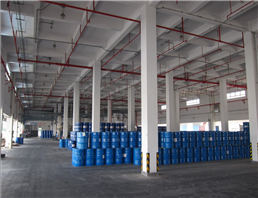
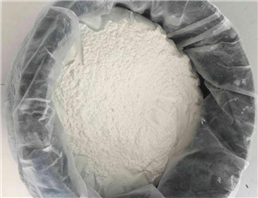
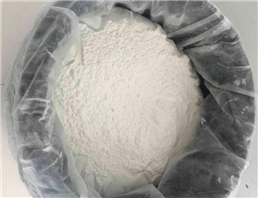
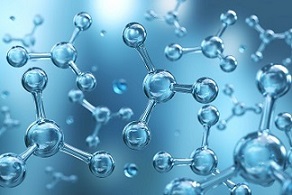
 China
China